
THE ETHICS OF BREEDING FOR DEFORMITY: BULLY SPHYNXES (BULLDOG-STYLE) AND SHORT-FACED SPHYNXES
In dogs, a "bully" breed refers to dogs with Bulldog or Pitbull characteristics: short, sometimes twisted, front legs; broad, deep chest; excessively wrinkled flat or blocky face with a wide muzzle. Unfortunately, a few cat breeders have applied these looks to hairless cats to produce a feline equivalent of the French Bulldog using the Bambino, a short-legged, hairless breed derived from Munchkin x Sphynx crosses. Why? They can sell "bully cats" for high prices to people who value novelty over health, and appearance over function. Despite breeders' claims that the cats are healthy, this conformation is associated with multiple problems. Some of those problems become apparent as the cat ages.
Nicknamed Bulbinos (bully Bambinos). "Bully cats" have been trademarked to circumvent the normal breed recognition process so that they are bred outside the auspices and regulations of a registry. Breeders talk about the "Bully cat scene" rather than the "cat fancy." As a multiple mutation breed (2 structural mutations + a physiological mutation + hairlessness), reputable registries will not accept them. TICA accepted them as an Experimental breed despite supposedly banning multiple mutation breeds. This compromises TICA's integrity and gives the bully cats a veneer of respectability.
(Breeders of these extreme cats are aggressive and threatening on Facebook, their interest being in the high prices commanded by these cats and not in their long-term health. Although I have original photographs showing the degree of deformity I am using my own drawings to show the level of deformity being selectively bred. The photos are screen-shots of newspaper articles.)
A MULTIPLE MUTATION BREED - 4 MUTATIONS.
1. The short legs of the Munchkin (and derivative Bambino breed) is due to the pseudochondroplasia mutation. Embryos with 2 copies of the gene die in utero. If not bred carefully, it can result in pectus excavatum and lordosis.
2. The hairlessness comes from the Sphynx / Bambino.
3. The extreme flat face and round, fat head purportedly came from undocumented crossing to short-faced Exotic Shorthairs whose conformation is due to mutations in CNTN6 and CHL1. It is associated with Brachycephalic Syndrome. This is seen in extreme Sphynxes and in "bully cats."
4. The dramatic over-muscled appearance (muscle hypertrophy) is usually caused by a defective muscle fibre gene. In animals with 2 copies of the gene it is associated with shortened life-span due to cardio-vascular issues (the heart is a muscle!) and seizures. Breeders are massively inbreeding these cats to be homozygous.

When all of these are combined, regardless of breeders' claims (these animals command high prices, remember), the twisted, wide-set forelegs and over-muscled shoulders impede mobility. The broad chest, combined with the short legs and abnormal shoulder conformation, is linked to lordosis and other spinal problems. The extreme short muzzle is associated with a multitude of well-documented, scientifically studied problems. You have only to look at the French Bulldog and English Bulldog to see the problems caused by such conformation.
EXCESSIVE SKIN FOLDS
Cats naturally have loose skin, but should not have the excessive skin folds seen in extrem Sphynxes and the "bully cats." As well as rubbing and chafing against each other, skin folds retain moisture which encourages bacterial and fungal infections. Dirt, food particles, tears and saliva get trapped in facial folds. Bacteria and fungi (e.g. yeasts) feed on skin secretions trapped in the folds, creating a perfect breeding ground for infections. These organisms also produce substances that cause further irritation to the skin. Infections can cause itchiness and ulceration. This is well documented in dog breeds such as the Shar Pei.
Wrinkled skin around the vulva and under the tail can cause infections in the urogenital region. Wrinkles around the armpits and thighs can result in painful rubbing.
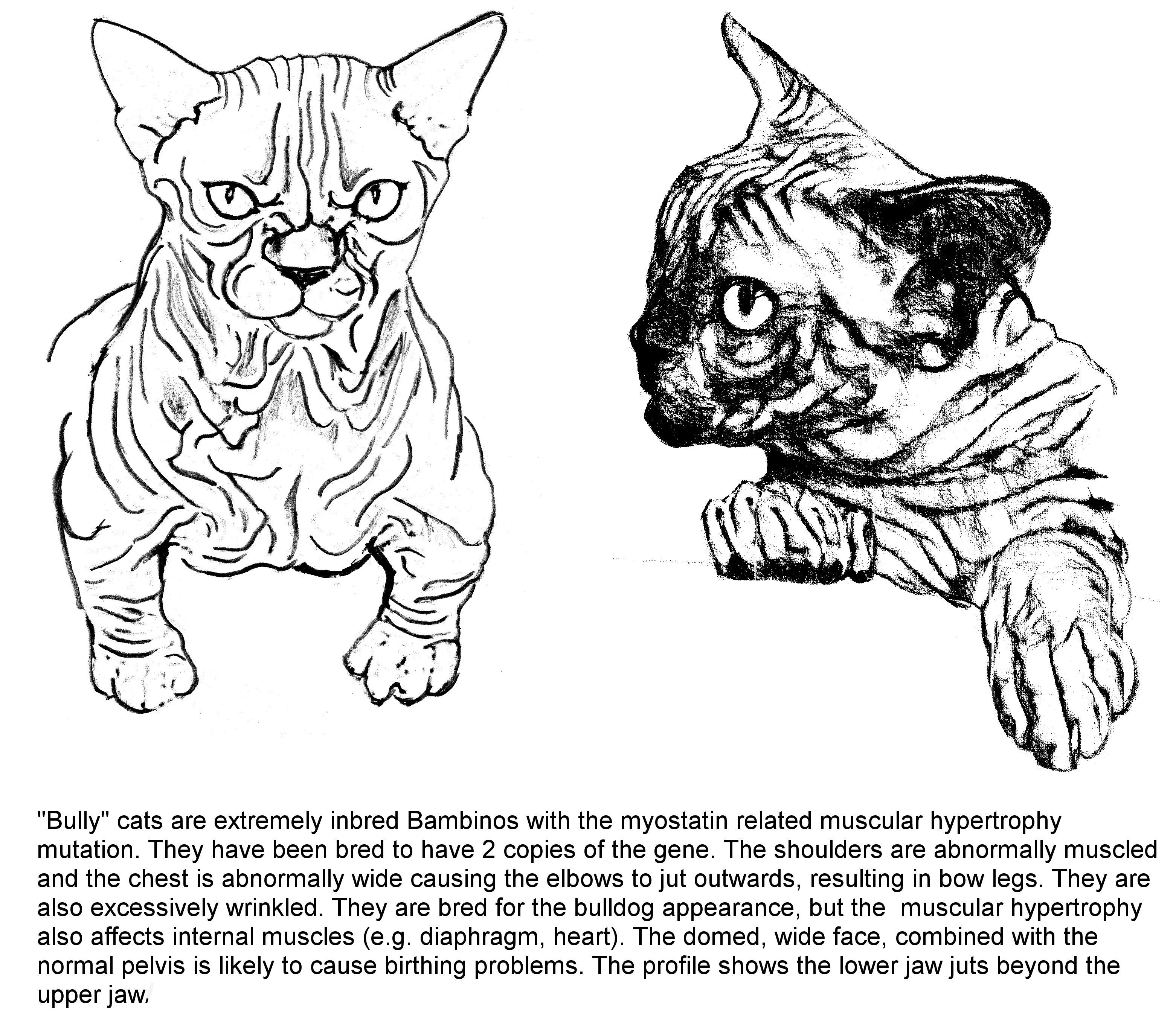
BRACHYCEPHALIC SYNDROME (BRACHYCEPHALIC OBSTRUCTIVE AIRWAY SYNDROME)
(Refer also to: Schmidt MJ, Kampschulte M, Enderlein S, et al. "The Relationship between Brachycephalic Head Features in Modern Persian Cats and Dysmorphologies of the Skull and Internal Hydrocephalus. "Journal of Veterinary Internal Medicine. 2017;31(5):1487-1501.)
Brachycephalic bully cats are following the same route as the flat-faced Persian/Exotic. The impact of this facial type has been extensively studied. There are published veterinary papers relating to problems caused by the extreme Persian/Exotic facial anatomy. The short-faced Sphynxes and bully cats face the same problems which are well documented in veterinary and scientific papers. The continued inbreeding indicated in social media posts will exacerbate these issues, ultimately leading to the collapse of the breed as it did in the Peke-Faced Persian.
- Distorted eye sockets and weeping eyes due to abnormal eyelid conformation and blocked or absent tear ducts. Tears become trapped in the facial folds causing irritation and infections.
- Teeth erupt at unusual angles preventing normal biting and chewing and allowing food particles to accumulate between the teeth, leading to plaque formation and gum disease.
- Constricted nostrils and high soft palate cause upper airway obstruction, noisy breathing, forcing affected cat to mouth-breathe.
- Brain is compressed into the wrong-sized cranial vault, this can result in obvious neurological symptoms such as mental dullness. There is a known link between the brachycephalic skull conformation and hydrocephalus.
- Rubbing the flattened face in the food bowl when eating - food becomes trapped in folds of muzzle and cheeks and even in the nostrils. This attracts bacteria into the skin folds.
- Jaw and Dental Defects due to the shortened jaws (brachygnathia). Shortened upper jaw means the lower jaw protrudes and points upwards ("bulldog jaw"). This causes problems with grooming, suckling or eating. The shortened muzzle and abnormal jaw conformation predisposes the cat to twisted or misaligned jaws and overcrowded or distorted teeth. The cat cannot effectively use its cheek teeth. The abnormal angles of the teeth means food easily accumulates between the teeth leading to plaque, tooth decay and gum disease.
- Umbilical Hernia in kittens because breeding females use their cheek teeth to cut the umbilical cord of kittens. Short-faced cats cannot effectively use their cheek teeth and end up pulling on the umbilical cord, causing hernia in the kittens.
The combination of skin folds and a short muzzle make it impossible for the cat to groom effectively, despite the lack of fur. Cats use their teeth to trim their hind claws; the distortion of the jaws and teeth impacts this ability.
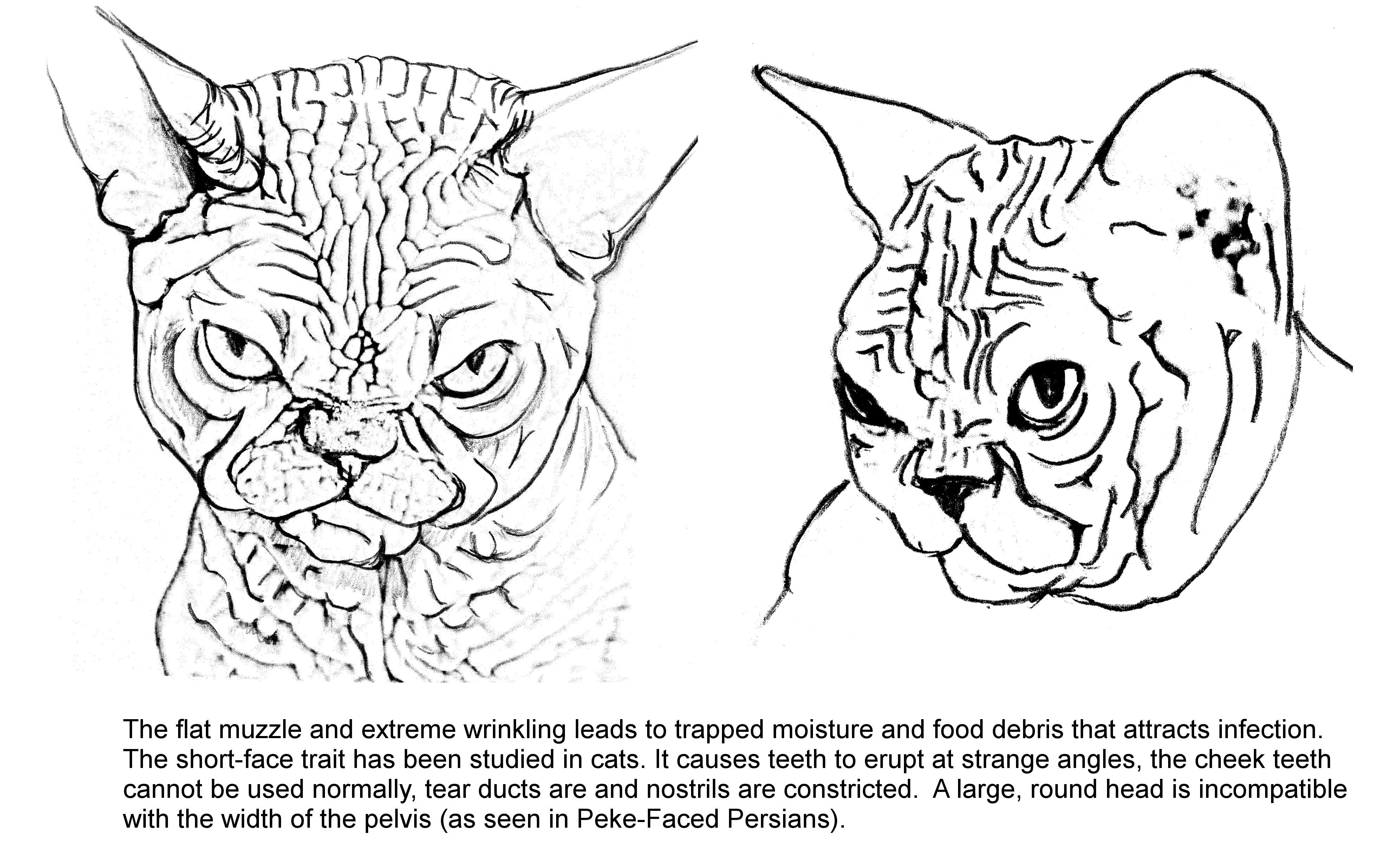
Appearance-oriented breeding to exaggerate a round- or fat-headed, flat-faced head shape leads to severe skull and brain abnormalities. Breeders and cat fanciers must accept that phenotypic traits desirable to the minority of people seeking "status animals is considered a severe developmental abnormality. Lessons from the dog breeding world are being ignored and cats are being subjected to deleterious extreme breeding that impacts function and wellbeing.
GENETIC MUTATIONS CAUSING BRACHYCEPHALY IN CATS
Although breeders often assume that brachycephalic conformation is an accentuation of a normal head shapes due to polygenes, it was caused by gene mutations (CNTN6 and CHL1 identified) in short-faced Persians. The skull conformation of the Peke-face Persian is a feline form of coronal craniosynostosis where one or more of the fibrous sutures in the skull of a very young infant prematurely fuses by turning into bone, which changes the growth pattern of the skull. Brachycephalic skull development has been studied and is well-documented in brachycephalic dogs and also in the Peke-Faced Persian.
The Peke-faced Persian showed neurological issues including dulled alertness. Like the bully cats, they had grossly reduced cranial length and increased width and height (the extreme "fat head" requested by buyers and would-be breeders of bully cats). The eye orbits were shallow, wide-set and tended to diverge, and the bone between the eyes was indented - a similar indent is seen in bully cats. The frontal sinus was small or absent and the nasal bone was notably short, or even absent. Inside the skull, the frontal lobes were compressed. There was severe dilatation of the lateral ventricles, reduction, and destruction of the cerebral parenchyma (the functional cells of the brain i.e. neurons and glial cells), hydrocephalus and severe cerebellar herniation into the vertebral canal (as seen in Cavalier King Charles Spaniels). Some kittens had to be euthanized because of hydrocephalus and severe cerebellar herniation.
The combination of large, round head and narrow pelvis increases the risk of caesarean births. An abnormally high palate affects the kittens' ability to suckle.
SHORT LEGS
Although Munchkins and derived breeds don't have the same spinal problems as short-legged dogs, the bully type cats have combined these with myostatin related muscular hypertrophy. This affects the muscling of the shoulder and angle of the elbows. The wide set of the shoulder does not allow the legs to support the weight normally and the cat must draw its paws together, under the chest with the elbows pointing outwards (bow legs). This is an unhealthy, unnatural posture which can lead to twisting, pain and joint conditions, and reluctance to move as the cat ages.
In "bully cats" the hind legs are similarly affected by muscle hypertrophy, producing splayed hindlimbs to accommodate the unnaturally wide, low body. A cat's hind limbs should act like supporting pillars and not be splayed to the side. A splayed conformation leads to hip and pelvic problems. The English Bulldog is an example and has reached the stage of routinely requiring caesarean section in order to give birth.
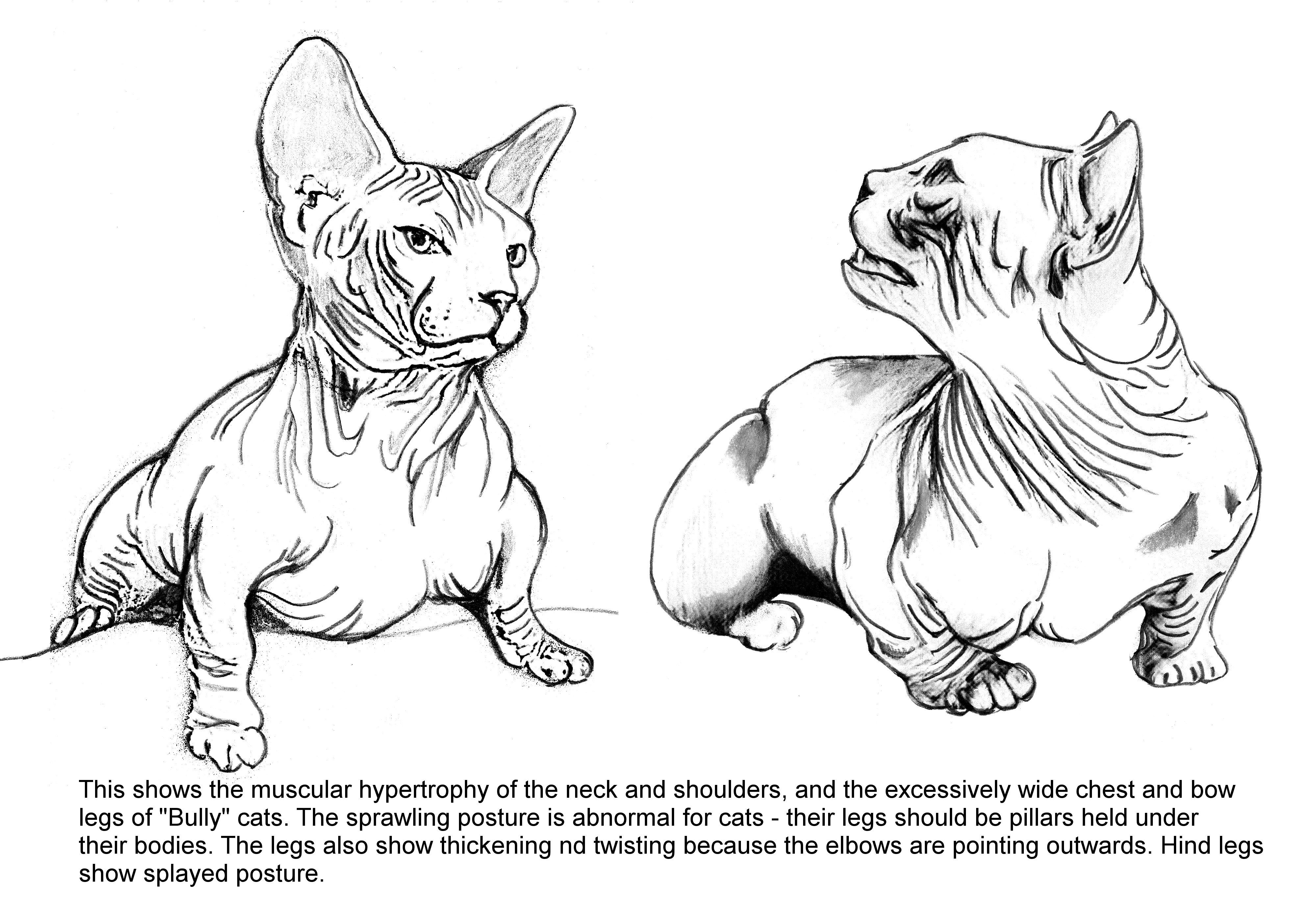
MYOSTATIN RELATED MUSCULAR HYPERTROPHY
In order to grow muscles properly, the body uses signalling proteins to tell cells to multiply or expand, while other signalling proteins inhibit that growth. Myostatin is one of the inhibitory proteins that operates inside muscle cells. A mutation in the gene encoding myostatin means muscles lack one of the key signals that tells them when to stop growing.
Each cat (and other mammals) has two copies of the gene encoding myostatin. Myostatin-related muscle hypertrophy is due to mutations in the MSTN gene. The mutation has an incomplete autosomal dominant pattern of inheritance. Inheriting one mutated copy (heterozygous for the gene and having less myostatin than normal) produces animals that are unusually muscular and strong, but without bulging muscles. Inheriting two mutated copies (homozygous - having no myostatin) produces abnormally bulging muscles. In December 2021, a Sphynx cat with bulging muscles appeared on Reddit and went viral. The cat suffered from myostatin-related muscle hypertrophy which caused its muscles to grow excessively large. It had prominent shoulders, large paws and a thick torso, with its unusual muscle structure being more apparent due to the lack of fur.
The mutation remains uncommon because the extra muscular bulk isn't always a good thing. While animals with one copy of the mutation may be stronger or faster, animals with two copies are overburdened with muscle and have other health issues. They also need a higher protein diet to build and maintain the muscle bulk. The potential benefits of having less myostatin than normal (heterozygous) are balanced out by the disadvantages of having no myostatin at all (homozygous). This prevents the mutation from disappearing, but also prevents animals from evolving into a species of double-muscled monstrosities.
Affected animals typically only have about 25 percent more muscle mass than unaffected animals, but their muscles look very well-defined due to the animals having less fat. Genetically engineered mice with no myostatin can grow 300 percent more muscle than normal. Belgian Blue cattle are referred to as "double-muscled." Their excessive muscle growth means they require an expensive high-protein diet and they lack the normal marbling of fat in their muscles. The massive size of their calves means caesarean sections are often required. "Bully" whippets with one copy of the mutation are stronger and faster, but those with two copies are over-muscled and slower. Goats and rabbits engineered without myostatin had enlarged tongues and a high rate of stillbirths due to bulky babies.
Cat breeders and owners only see the impact of muscular hypertrophy on skeletal muscles i.e. the "ripped" look. Internal muscles are also affected: a thickened diaphragm affects breathing; muscles around the oesophagus affect swallowing; the heart muscle becomes thickened.
SIMILAR-LOOKING MUTATIONS
Muscular hypertrophy can be caused by different mutations that affect muscle growth. Breeders who are motivated by novelty and money, or want to cash in on a trend, will look for cats that resemble "bully" cats. As well as myostatin related muscular hypertrophy, there is a similar-looking lethal condition called hypertrophic feline muscular dystrophy (HFMD)/dystrophin deficient muscular dystrophy (DDMD). Kittens with this condition may be mis-sold as "bully" cats.
DYSTROPHIN DEFICIENCY CAUSES LETHAL MUSCLE HYPERTROPHY IN CATS (Frederic P. Gaschen, Eric P. Hoffman, J.Rafael M. Gorospe, Elizabeth W. Uhl, David F. Senior, George H. Cardinet, Laurie K. Pearce, Journal of the Neurological Sciences, Volume 110, Issues 1-2, 1992, Pages 149-159, https://doi.org/10.1016/0022-510X(92)90022-D )
Abstract: Two 5-month-old male Domestic Shorthair littermates showed general skeletal muscle hypertrophy, multifocal submucosal lingual calcification with lingual [tongue] enlargement, and excessive salivation. Both cats had a reduced level of activity, walked with a stiff gait, and tended to "bunny hop" when they ran. These clinical features were similar to those of previously reported dystrophin-deficient cats. Using multiple dystrophin antibodies, we found that the cats described in this report also showed marked dystrophin deficiency. The histopathology was remarkable for hypertrophy and splitting of fibres, and progressive accumulation of calcium deposits within the muscle. There was little or no endomysial fibrosis at 2 years of age. The natural history of dystrophin-deficiency in cats has not been described: both previous cats had been euthanized at 2 years of age prior to experiencing any life-threatening problems. At 6 months of age, one of the new cats developed megaoesophagus because of severe progressive hypertrophy of the diaphragmatic muscles. The diaphragm completely occluded the oesophagus, and the cat was euthanized for humane reasons. The second cat remained in good condition until age 18 months when it developed acute renal failure attributed to severe prolonged dehydration and hyperosmolality [the blood has a high concentration of sodium, glucose, and other substances; this draws the water out of the body's other organs, including the brain]. The cat recovered after receiving supportive treatment but was unable to maintain fluid homeostasis. The insufficient water intake was attributed to glossal [tongue] hypertrophy and dysfunction. At age 2 years, the cat received regular subcutaneous injections of low-sodium fluids to maintain proper hydration. The clinical consequence of dystrophin deficiency in cats is lethal muscle hypertrophy. We have called the feline disease "hypertrophic feline muscular dystrophy" (HFMD).
A CASE OF HYPERTROPHIC FELINE MUSCULAR DYSTROPHY IN A BELGIAN DOMESTIC SHORTHAIR CAT (I. Van Soens, N. Mols, S. Van Meervenne, T. Bilzer, T. Waelbers, D. Binst, M. Tshamala, A. Verhaeghe, J. Saunders, 1L. Van Ham). Vlaams Diergeneeskundig Tijdschrift (Flemish Veterinary Journal), 2009, 78.
A 3-year-old, male domestic shorthair cat was presented with signs of progressive muscular hypertrophy. A diagnosis of hypertrophic feline muscular dystrophy was made on the basis of the typical clinical presentation in cats and on the basis of the results of medical imaging, the electrodiagnostics and the findings on histopathology and immunohistochemistry of muscle biopsies. The cat was initially successfully treated with prednisolone. Eight months after presentation, however, the cat was euthanized because of acute renal failure.
ETHICAL ISSUES
The public will be buying cats that may, as they mature, need extensive and expensive veterinary care for an array of health issues associated with extreme conformation and with the physiological issues related to myostatin mutations. Insurance companies may refuse to insure such cats because of the unknown health problems. Breeders of these cats are selling kittens that appear healthy, but with little knowledge of the long-term health issues over a cat's 15+ year lifespan. Other breeders, wanting to cash in, are likely to pass off cats with a similar appearance, but with a different mutation that causes death before the age of three years.
Online, buyers are requesting extremely inbred cats with "a fat head, big bone, wide spread" and are willing to pay up to $10,000 for a breeding female. Extremely inbred means repeated father-daughter mating and brother-sister mating. The doubling up of genes not only creates the extreme look by producing homozygous cats, it brings out additional recessive genes harmful to health. Some social media posts request cats with "2 x stud A, 2 x stud B and 2 x stud C" in the pedigree. The fact that breeding females command such high prices means these are not companion animals, they are kitten-producing commodities sold to misguided individuals. There is the risk that they will be discarded if they become unable to breed (or require expensive c-sections), something seen in the dog world.
It seems that people who are attracted to extreme bully type dogs are damaging cats to create feline analogues of English Bulldogs and French Bulldogs. It is not a healthy or natural conformation and most registries will not accept them. In Europe the conformation would be banned under existing legislation and they could not be legally bred. This will not stop unethical back-yard breeders who put money above health.
SHORT-FACED / DOME-HEADED EXTREME SPHYNXES
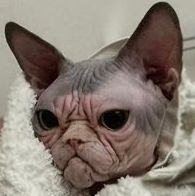
Short-faced, excessively wrinkled Sphynxes have appeared in Russia, though I have no further information. In the USA, Sphynxes with unusually short faces and domed heads are appearing. The Sphynx standard (TICA, CFA) requires a modified wedge-shaped head with rounded contours, slightly longer than wide, slightly rounded skull and rather flat forehead. It is questionable whether the dome-headed Sphynx meet these criteria. It is alleged that Sphynxes have been crossed to Exotic Shorthairs, but documentary evidence is hard to find. The domed head trait is now cropping up unwanted in Sphynx lines.
Of late, a number of short-faced Sphynxes have been bred. It is alleged (though I have no documentary evidence) that a TICA judge has been involved in these crosses. The short-face and domed head in Persian/Exotic cats has previously been found to be due to mutations in the CNTN6 and CHL1 genes. This would mean that short-faced Sphynxes are multiple-mutation breeds, something TICA supposedly disallows.
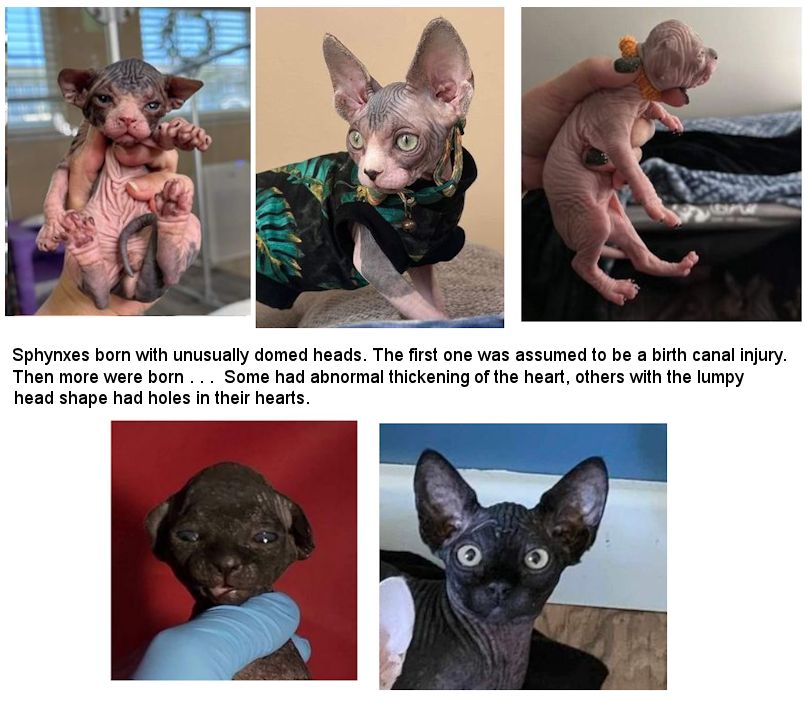
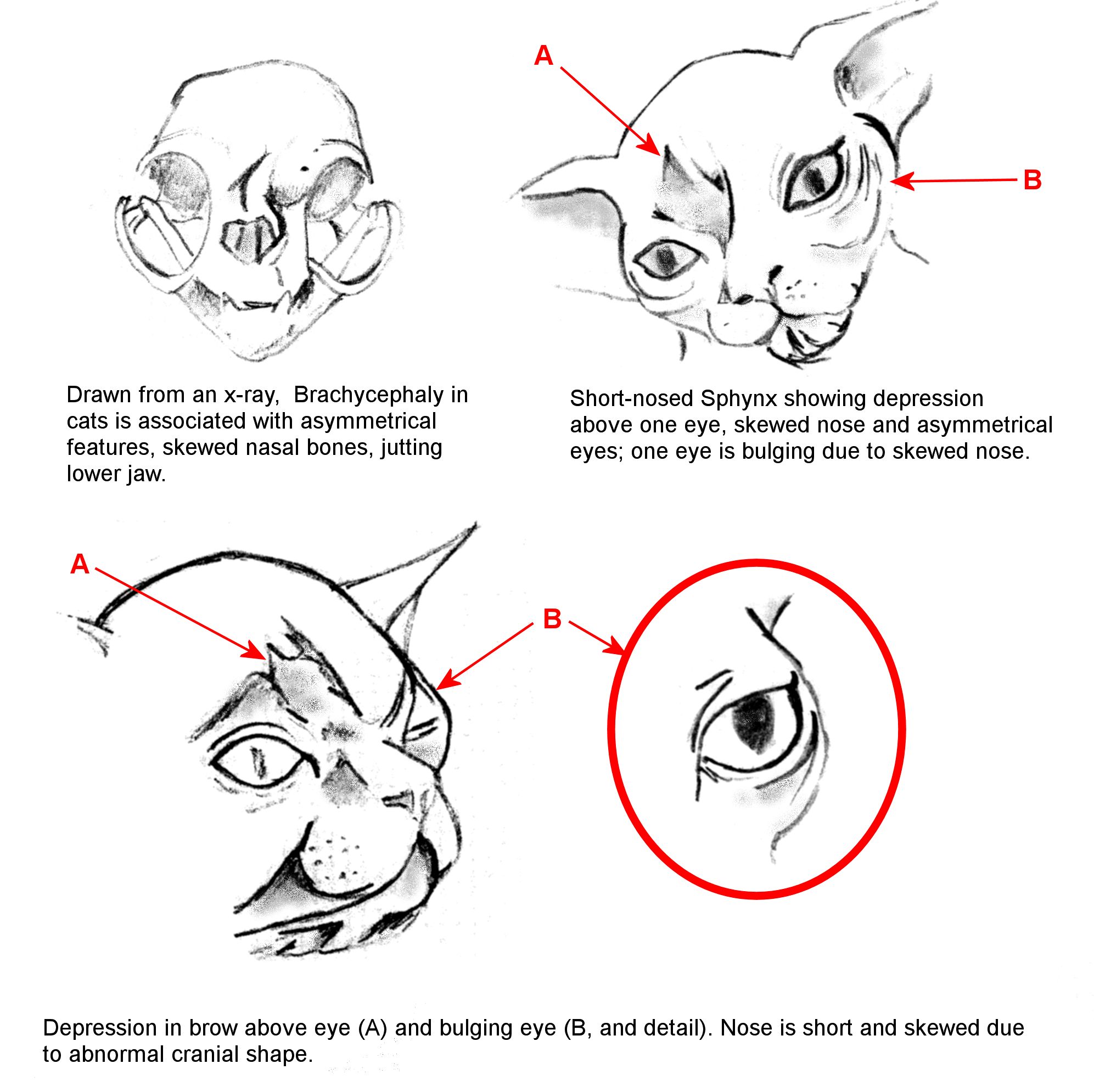
Another issue found in several related lines of Sphynx is the "cone head" or "lumpy head." Initially blamed on birth canal injury, family tree analysis shows it is an inherited trait. Kittens are born with prominent domed heads. The shape is less obvious in adults, but points to an unwanted mutation. A number of lumpy-headed kittens also had thickened heart walls or holes in their hearts.
EXISTING LEGISLATION
The "European Convention for the Protection of Pet Animals" was issued by the Council of Europe and potentially bans genetically defective and ultra-typed breeds. The section on facial defects covers brachycephaly and brachygnathia (short muzzle) and recommends breeding associations determine an index defining over-typing, banning the breeding of over-typed cats. The UK has not signed up to the European legislation so any changes are voluntary and often driven by public pressure. Public pressure is mainly linked to dangerous dogs, rather than physical conformation of cats and dogs.
American cat breeders are concerned that an equivalent "Convention for the Protection of Pets" could happen in their own country and consider it their right to breed cats to extremes, regardless of associated health issues. The US government's Animal Welfare Act regulates conditions in breeding facilities, research facilities and shows, but breeding ethics remain the province of breeders and breed societies and are jealously guarded from interference.
If, as is alleged, registry judges are breeding extreme types of Sphynx or multiple mutation cats despite the registry's own rules, then that registry is no longer fit to govern its members. It has lost its integrity. Health, function and wellbeing should be made an integral part of breed standards in companion animals. Because cats and dogs are not bred for meat, muscular hypertrophies should not be the basis for breeds.
REFERENCES AND FURTHER READING
LEGISLATION AGAINST EXTREME TYPING, DEFORMITY AND GENETIC DEFECTs
Bertolini, F., Gandolfi, B., Kim, E.S. et al. Evidence of selection signatures that shape the Persian cat breed Mamm Genome (2016) 27: 144.
Breit S, K nzel W, Oppel M. The course of the nasolacrimal duct in brachycephalic cats. Anat Histol Embryol 2003; 32: 224-27.
Hobson HP. Brachycephalic syndrome. Semin Vet Med Surg (Small Anim) 1995; 10: 109-14.
K nzel W, Breit S, Oppel M. Morphometric investigations of breed-specific features in feline skulls and considerations on their functional implications. Anat Histol Embryol 2003; 32: 218-23.
Malik, R. Brachycephalia - a bastardisation of what makes cats special (editorial); Journal of Feline Medicine and Surgery (2009) 11, 889-890
Noeller C. CT-anatomy of the brachycephalic and normal feline nasolacrimal drainage system [abstract]. Vet Radiol Ultrasound 2008; 49: 207.
Schlueter C, Budras KD, Ludewig E, et al.. Brachycephalic feline noses CT and anatomical study of the relationship between head conformation and the nasolacrimal drainage system; Journal of Feline Medicine and Surgery (2009) 11, 891-900
Schmidt MJ, Kampschulte M, Enderlein S, et al. The Relationship between Brachycephalic Head Features in Modern Persian Cats and Dysmorphologies of the Skull and Internal Hydrocephalus." Journal of Veterinary Internal Medicine. 2017;31(5):1487-1501